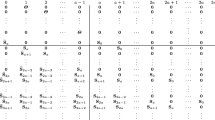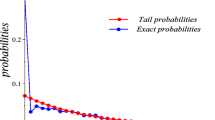Abstract
In this paper, we compute the probability generating functions (PGF’s) of the customer delay for two batch-service queueing models with batch arrivals. In the first model, the available server starts a new service whenever the system is not empty (without waiting to fill the capacity), while the server waits until he can serve at full capacity in the second model. Moments can then be obtained from these PGF’s, through which we study and compare both systems. We pay special attention to the influence of the distribution of the arrival batch sizes. The main observation is that the difference between the two policies depends highly on this distribution. Another conclusion is that the results are considerably different as compared to Bernoulli (single) arrivals, which are frequently considered in the literature. This demonstrates the necessity of modeling the arrivals as batches.
Similar content being viewed by others
References
Bruneel H (1983) Buffers with stochastic output interruptions. Electron Lett 19: 461–463
Bruneel H (1985) Some remarks on discrete-time buffers with correlated arrivals. Comput Oper Res 12(5): 445–458
Chang SH, Choi DW (2005) Performance analysis of a finite-buffer discrete-time queue with bulk arrival, bulk service and vacations. Comput Oper Res 32: 2213–2234
Chang SH, Takine T (2005) Factorization and stochastic decomposition properties in bulk queues with generalized vacations. Queue Syst 50: 165–183
Chaudhry ML, Templeton JGC (1983) A first course in bulk queues. Wiley, New York
Chen Y, Qiao C, Yu X (2004) Optical burst switching (OBS): a new area in optical networking research. IEEE Netw 18(3): 16–23
Claeys D, Walraevens J, Laevens K, Bruneel H (2007) A discrete-time queueing model with a batch server operating under the minimum batch size rule, NEW2AN2007. Lect Notes Comput Sci 4712: 248–259
Claeys D, Laevens K, Walraevens J, Bruneel H (2008) Delay in a discrete-time queueing model with batch arrivals and batch services. Proceedings of the fifth international conference on information technology: new generations, pp 1040–1045
Downton F (1955) Waiting time in bulk service queues. J Roy Stat Soc Ser B (Methodological) 17(2): 256–261
Janssen AJEM, van Leeuwaarden JSH (2005) Analytic computation schemes for the discrete-time bulk service queue. Queue Syst 50: 141–163
Kim NK, Chae KC, Chaudhry ML (2002) An invariance relation and a unified method to derive stationary queue lengths. Oper Res 52(5): 756–764
Kim NK, Chaudhry ML (2006) Equivalences of batch-service queues and multi-server queues and their complete simple solutions in terms of roots. Stoch Anal Appl 24: 753–766
Klimenok V (2001) On the modification of Rouche’s theorem for the queueing theory. Queue Syst 38: 431–434
Medhi J (1975) Waiting time distributions in a poisson queue with a general bulk service rule. Manage Sci 21(2): 777–782
Qiao CM, Yoo MS (1999) Optical burst switching (OBS)—a new paradigm for an optical internet. J High Speed Netw 8(1): 69–84
Zhao YQ, Campbell LL (1996) Equilibrium probability calculations for a discrete-time bulk queue model. Queue Syst 22: 189–198
Author information
Authors and Affiliations
Corresponding author
Rights and permissions
About this article
Cite this article
Claeys, D., Walraevens, J., Laevens, K. et al. Delay analysis of two batch-service queueing models with batch arrivals: Geo X/Geo c/1. 4OR-Q J Oper Res 8, 255–269 (2010). https://doi.org/10.1007/s10288-009-0111-2
Received:
Revised:
Published:
Issue Date:
DOI: https://doi.org/10.1007/s10288-009-0111-2




